Leveraging Geospatial Information to Map Perceived Tenure Insecurity in Urban Deprivation Areas
Abstract
1. Introduction
2. Materials and Methods
2.1. The Study Area
2.2. Data
2.2.1. Household Survey Data
2.2.2. Very High-Resolution Satellite Imagery and Spatial Data
2.3. Methods
2.3.1. Overall Workflow
2.3.2. Characterising the Variation of Perceived Tenure Insecurity from Survey Data
2.3.3. Extracting Spatial Characteristics of the Deprived Area in the Study Area
2.3.4. Relating Spatial Characteristics of the Deprived Area to Perceived Tenure Security
3. Results
3.1. Overview of Survey Results
3.2. Patterns of Perceived Tenure Insecurity
3.3. Spatial Characteristics of the Urban Deprived Areas
3.4. Relationship between Perceived Tenure Insecurity and Spatial Characteristics of Urban Deprived Areas
4. Discussion
4.1. The Interpretation of Survey Results
4.2. The Variation of Perceived Tenure Insecurity in the Urban Deprived Area
4.3. Spatial Characteristics of the Urban Deprived Area
4.4. Relationship between Spatial Characteristics of Urban Deprived Area and Variation of Perceived Tenure Insecurity
4.5. Limitation
5. Conclusions
Author Contributions
Funding
Data Availability Statement
Conflicts of Interest
Appendix A
| Indicator | Research | Comment |
|---|---|---|
| Duration of land or property ownership | [4]; [6]; [19]; [26]; [62]; [10]; [11] | The long or short period that landholder occupy the land/ property and living or nor living in fear of losing the land/property induce the perception of tenure insecurity |
| Land or property acquisition | Informal or formal land acquisition | |
| Expected occupation period in the future | The likelihood of living or holding the land/property in the coming period of time | |
| Types of rights to land/property | Bundle of rights to land enjoyed by the land and property holders | |
| Recognition and protection of rights to land/property | Legal or de facto recognition of rights to land/property | |
| Proof or evidence for rights to land/property | Documents proving the rights to land/property of land and property holders | |
| Experience of eviction | Previous eviction and the causes of it | |
| Likelihood to lose land/property unwillingly in the coming period of time (5 years) | Fear of event that can happen and make land/property holders to lose their rights to land/property | |
| Physical/environmental characteristics | [9]; [12]; [48]; [49]; [50]; | Feeling insecure reduces the willingness to invest in land/property. Thus, areas with high tenure insecurity can be characterized by inadequate housing and environmental conditions. |
| Indicators | p-Value |
|---|---|
| Wall materials | 3.21 × 10−26 |
| Location of the neighbourhood | 1.56 × 10−21 |
| Household access to water | 4.58 × 10−15 |
| Likelihood to lose popery in the next 5 years | 7.65 × 10−12 |
| House condition | 8.80 × 10−12 |
| Occupation time | 9.94 × 10−12 |
| Events that are likely to happen in case of loss of the property | 1.21 × 10−11 |
| The shape of the house | 1.72 × 10−10 |
| Presence of wastes | 9.17 × 10−10 |
| Garbage pick-up services | 4.71 × 10−9 |
| Feelings of staying in the same property in the future | 5.04 × 10−9 |
| The size of the house | 7.70 × 10−9 |
| Dominant building size in the neighbourhood | 5.01 × 10−7 |
| Household access to the unpaved road | 2.33 × 10−6 |
| Property acquisition types | 1.39 × 10−4 |
| Eviction experience | 9.20 × 10−4 |
| Access to green space | 7.89 × 10−3 |
| Presence of unpaved road in the neighbourhood | 1.29 × 10−2 |
| Access to public water taps | 2.56 × 10−2 |
| Presence of unpaved footpath | 4.13 × 10−2 |
| Cluster 1 | |
|---|---|
| Variables | Test statistic |
| Event in case of loss of property: Relocation | 6.61 |
| Location of the neighbourhood: Proximity to wetland | 5.35 |
| Location of the neighbourhood: Proximity to ditch | 4.48 |
| Eviction experience: No | 3.79 |
| Property acquisition: Inherited from my family | 3.7 |
| Likelihood to lose popery in the next 5 years: Very likely | 2.93 |
| Household access to water: No | 2.79 |
| Wall material: Unburnt brick | 2.65 |
| Dominant building size in the neighbourhood: Medium | 2.57 |
| Access to green space: Yes | 2.49 |
| Access to public water taps: No | 2.25 |
| Protection in case of loss: Very strongly | 2.18 |
| Location of the neighbourhood: Proximity to the road | 2.17 |
| House condition: Old | 2.14 |
| Cluster 2 | |
| Variables | Test statistic |
| Household access to water: No | 6.59 |
| Wall material: Unburnt brick | 6.43 |
| Location of the neighbourhood: Steep slope | 6.38 |
| Dominant building size in the neighbourhood: Small | 5.87 |
| House size: Small | 5.5 |
| Presence of wastes: No | 5.47 |
| Garbage pickup: No | 5.33 |
| Occupation time: Between 5 and 10 years | 5.14 |
| Likelihood to lose popery in the next 5 years: Very likely | 5.14 |
| Household access to unpaved road: No | 3.76 |
| House shape: Simple shape | 3.16 |
| Unpaved roads: No | 2.92 |
| Event in case of loss of property: Land readjustment | 2.75 |
| Household access electricity: No | 2.16 |
| Cluster 3 | |
| Variables | Test statistic |
| Wall material: Burnt brick | 7.29 |
| Presence of wastes: Yes | 5.09 |
| Occupation time: Longer than 10 Years | 4.81 |
| Garbage pickup: Yes | 4.76 |
| Household access to water: Yes | 4.45 |
| Occupation time in the future: Longer than 10 Years/lifelong | 4.41 |
| Likelihood to lose popery in the next 5 years: Unlikely | 4 |
| House condition: Old | 3.72 |
| House size: Medium | 3.71 |
| Dominant building size in the neighbourhood: Medium | 3.55 |
| Event in case of loss of property: Upgrading | 3.18 |
| Location of the neighbourhood: Moderate slope | 2.91 |
| Household access to unpaved road: Yes | 2.46 |
| Household access to footpath: No | 2.13 |
| Location of the neighbourhood: Proximity to watershed | 2.01 |
| Unpaved roads: Yes | 2 |
| Cluster 4 | |
| Variables | Test statistic |
| Wall material: Concrete | 7.92 |
| House condition: New | 7.27 |
| House shape: Complex shape | 5.99 |
| Household access to water: Yes | 5.47 |
| Occupation time: Between 1 and 5 years | 4.51 |
| Occupation time in the future: Longer than 10 Years/lifelong | 4 |
| Location of the neighbourhood: Moderate slope | 3.93 |
| Household access to unpaved road: Yes | 3.93 |
| Likelihood to lose popery in the next 5 years: Somewhat likely | 3.77 |
| Occupation time: Between 5 and 10 years | 3.72 |
| House size: Medium | 2.89 |
| House size: Large | 2.69 |
| Likelihood to lose popery in the next 5 years: Very unlikely | 2.69 |
| Eviction experience: Yes | 2.67 |
| Property acquisition: Bought from the private individual | 2.59 |
| Event in case of loss of property: Land readjustment | 2.37 |
| Garbage pickup: Yes | 2.09 |
References
- UN-Habitat. Urbanization and Development: Emerging Futures. 2016. Available online: https://unhabitat.org/sites/default/files/download-manager-files/WCR-2016-WEB.pdf (accessed on 22 May 2020).
- Friesen, J.; Friesen, V.; Dietrich, I.; Pelz, P.F. Slums, space, and state of health—A link between settlement morphology and health data. Int. J. Environ. Res. Public Health 2020, 17, 2022. [Google Scholar] [CrossRef] [PubMed]
- Kuffer, M.; Thomson, D.R.; Boo, G.; Mahabir, R.; Grippa, T.; Vanhuysse, S.; Engstrom, R.; Ndugwa, R.; Makau, J.; Darin, E.; et al. The role of earth observation in an integrated deprived area mapping ‘system’ for low-to-middle income countries. Remote Sens. 2020, 12, 982. [Google Scholar] [CrossRef]
- UN-Habitat. Tenure Security, Land and Property Rights in an Urban Context. 2015. Available online: https://www.habitat.org/sites/default/files/Tenure_Security_Land%26Property_Rights_in_an%20Urban_Context_emea_2017.pdf (accessed on 11 November 2020).
- Lilford, R.; Taiwo, O.J.; de Albuquerque, J.P. Characterisation of urban spaces from space: Going beyond the urban versus rural dichotomy. Lancet Public Health 2018, 3, E61–E62. [Google Scholar]
- Fenyes, T.I. Land tenure and rural development, Proceedings of a workshop, Rhodes University. In Development Southern Africa; FAO: Rome, Italy, 2002; Volume 3. [Google Scholar] [CrossRef]
- Durand-Lasserve, A. Urban and Rural Inhabitants’ Insecure Real Estate and Land Rights. In Take Back the Land! The Social Function of Land and Housing, Resistances & Alternatives; Mathivet, C., Ed.; Ritimo: Paris, France, 2012; p. 183. [Google Scholar]
- van Gelder, J.-L. Legal Tenure Security, Perceived Tenure Security and Housing Improvement in Buenos Aires: An Attempt towards Integration. Int. J. Urban Reg. Res. 2009, 33, 126–146. [Google Scholar]
- Moroni, S. Property as a human right and property as a special title. Rediscussing private ownership of land. Land Use Policy 2018, 70, 273–280. [Google Scholar]
- Reerink, G.; van Gelder, J.-L. Land titling, perceived tenure security, and housing consolidation in the kampongs of Bandung, Indonesia. Habitat Int. 2010, 34, 78–85. [Google Scholar]
- imbizi, M.C.D.; Bennett, R.M.; Zevenbergen, J. Land tenure security: Revisiting and refining the concept for Sub-Saharan Africa’s rural poor. Land Use Policy 2014, 36, 231–238. [Google Scholar]
- Nakamura, S. Revealing invisible rules in slums: The nexus between perceived tenure security and housing investment. Habitat Int. 2016, 53, 151–162. [Google Scholar]
- United Nations. Transforming Our World: The 2030 Agenda for Sustainable Development United Nations United Nations Transforming Our World: The 2030 Agenda for Sustainable Development. A/RES/70/1. 2015. Available online: https://www.un.org/en/development/desa/population/migration/generalassembly/docs/globalcompact/A_RES_70_1_E.pdf (accessed on 20 May 2020).
- Abascal, Á.; Rothwell, N.; Shonowo, A.; Thomson, D.R.; Elias, P.; Elsey, H.; Kuffer, M. “Domains of Deprivation Framework” for Mapping Slums, Informal Settlements, and other Deprived Areas in LMICs to Improve Urban Planning and Policy: A Scoping Review. 2021. Preprints. Available online: https://www.preprints.org/manuscript/202102.0242/v2 (accessed on 17 April 2021).
- Arribas-Bel, D.; Patino, J.E.; Duque, J.C. Remote sensing-based measurement of Living Environment Deprivation: Improving classical approaches with machine learning. PLoS ONE 2017, 12, e0176684. [Google Scholar]
- Duque, J.C.; Patino, J.E.; Ruiz, L.A.; Pardo-Pascual, J.E. Measuring intra-urban poverty using land cover and texture metrics derived from remote sensing data. Landsc. Urban Plan. 2015, 135, 11–21. [Google Scholar]
- Brown, M.; Hughes, A.K. Is Land Tenure ‘Secure Enough’ in Rural Rwanda? In Proceedings of the 2017 World Bank Conference on Land and Poverty, Washington, DC, USA, 20–24 March 2017; p. 28. Available online: https://www.chemonics.com/wp-content/uploads/2017/03/Secure-Enough-Land-Tenure_2017.pdf (accessed on 26 January 2021).
- Fosudo, O.P. Land Tenure Regularization in Rwanda: The Outcome for Agricultural Land Use Change in Peri-Urban Kigali. 2014. Available online: https://essay.utwente.nl/84408/1/fosudo.pdf (accessed on 6 March 2021).
- Prindex. Global Perceptions of Tenure Security: Looking beyond the Formalization of Property Rights. 2020. Available online: https://www.prindex.net/documents/529/Prindex-Policy_Brief-Rights_vs_Perceptions-6May.pdf (accessed on 12 January 2021).
- Baffoe, G.; Malonza, J.; Manirakiza, V.; Mugabe, L. Understanding the concept of neighbourhood in Kigali City, Rwanda. Sustainability 2020, 12, 1555. [Google Scholar] [CrossRef]
- Esmail, S.; Corburn, J. Struggles to remain in Kigali’s ‘unplanned’ settlements: The case of Bannyahe. Environ. Urban 2020, 32, 19–36. [Google Scholar] [CrossRef]
- Finn, B. Quietly Chasing Kigali: Young Men and the Intolerance of Informality in Rwanda’s Capital City. Urban Forum. 2018, 29, 205–218. [Google Scholar]
- Nikuze, A.; Sliuzas, R.; Flacke, J. From closed to claimed spaces for participation: Contestation in urban redevelopment induced-displacements and resettlement in Kigali, Rwanda. Land 2020, 9, 212. [Google Scholar] [CrossRef]
- Ali, D.A.; Deininger, K.; Goldstein, M. Environmental and gender impacts of land tenure regularization in Africa: Pilot evidence from Rwanda. J. Dev. Econ. 2014, 110, 262–275. [Google Scholar]
- Prindex. Global Perceptions of Urban Land Tenure Security Evidence from 33 Countries. 2019. Available online: https://www.prindex.net/reports/global-perceptions-urban-land-tenure-security-report-evidence-33-countries/ (accessed on 24 May 2020).
- NISR, Rwanda Statistical YearBook 2018, Kigali, 2018. Available online: https://www.statistics.gov.rw/publication/statistical-yearbook-2018 (accessed on 9 May 2024).
- City of Kigali, “Masterplan 2050”, Kigali, 2019. Available online: https://masterplan.kigalicity.gov.rw/portal/sharing/rest/content/items/ecd3119c441a4dc89eb226719adbeafc/data (accessed on 22 February 2021).
- City of Kigali, Zoning Regulations: Kigali Master Plan 2050, Kigali City, 2019. Available online: https://masterplan2020.kigalicity.gov.rw/portal/sharing/rest/content/items/b9e31b07d8684053b0f3eac8649e1213/data (accessed on 22 February 2020).
- Di Franco, G. Multiple correspondence analysis: One only or several techniques? Qual. Quant. 2016, 50, 1299–1315. [Google Scholar]
- Ayele, D.; Zewotir, T.; Mwambi, H. Multiple correspondence analysis as a tool for analysis of large health surveys in African settings. Afr. Health Sci. 2014, 14, 1036–1045. [Google Scholar]
- Ajami, A.; Kuffer, M.; Persello, C.; Pfeffer, K. Identifying a Slums’ Degree of Deprivation from VHR Images Using Convolutional Neural Networks. Remote Sens. 2019, 11, 1282. [Google Scholar] [CrossRef]
- Lawana, N.; Booysen, F. Decomposing socioeconomic inequalities in alcohol use by men living in South African urban informal settlements. BMC Public Health 2018, 18, 993. [Google Scholar] [CrossRef]
- Lana, R.M.; Riback, T.I.S.; Lima, T.F.M.; Da Silva-Nunes, M.; Cruz, O.G.; Oliveira, F.G.S.; Codeço, C.T. Socioeconomic and demographic characterization of an endemic malaria region in Brazil by multiple correspondence analysis. Malar. J. 2017, 16, 397. [Google Scholar]
- Greenacre, M.; Blasius, J. Multiple Correspondence Analysis and Related Methods. In Multiple Correspondence Analysis and Related Methods; Chapman and Hall/CRC: Boca Raton, FL, USA, 2006. [Google Scholar]
- Liu, Y.; Hayes, D.N.; Nobel, A.; Marron, J.S. Statistical significance of clustering for high-dimension, low-sample size data. J. Am. Stat. Assoc. 2008, 103, 1281–1293. [Google Scholar] [CrossRef]
- Sameen, M.I.; Pradhan, B.; Aziz, O.S. Classification of very high-resolution aerial photos using spectral-spatial convolutional neural networks. J. Sens. 2018, 2018, 7195432. [Google Scholar]
- Nivaggioli, A.; Randrianarivo, H. Weakly Supervised Semantic Segmentation of Satellite Images. In Proceedings of the 2019 Joint Urban Remote Sensing Event (JURSE), Vannes, France, 22–24 May 2019; pp. 1–4. [Google Scholar]
- Kuffer, M.; Pfeffer, K.; Sliuzas, R.; Baud, I. Extraction of Slum Areas from VHR Imagery Using GLCM Variance. IEEE J. Sel. Top. Appl. Earth Obs. Remote Sens. 2016, 9, 1830–1840. [Google Scholar] [CrossRef]
- Mboga, N.; Persello, C.; Bergado, J.; Stein, A. Detection of Informal Settlements from VHR Images Using Convolutional Neural Networks. Remote Sens. 2017, 9, 1106. [Google Scholar] [CrossRef]
- Georganos, S.; Gadiaga, A.N.; Linard, C.; Grippa, T.; Vanhuysse, S.; Mboga, N.; Lennert, M. Modelling the Wealth Index of Demographic and Health Surveys Within Cities Using Very High-Resolution Remotely Sensed Information. Remote Sens. 2019, 11, 2543. [Google Scholar] [CrossRef]
- Perez-Heydrich, C.; Warren, J.L.; Burgert, C.R.; Emch, M.E. Influence of Demographic and Health Survey Point Displacements on Raster-Based Analyses. Spat. Demogr. 2016, 4, 135–153. [Google Scholar] [CrossRef]
- Breiman, L. Random Forests. Mach. Learn. 2001, 45, 5–32. [Google Scholar] [CrossRef]
- Stevens, F.R.; Gaughan, A.E.; Linard, C.; Tatem, A.J. Disaggregating Census Data for Population Mapping Using Random Forests with Remotely-Sensed and Ancillary Data. PLoS ONE 2015, 10, e0107042. [Google Scholar]
- Ngoga, T. Land Governance Assessment Framework Final Report: Rwanda. 2016. Available online: https://openknowledge.worldbank.org/bitstream/handle/10986/28492/119631-WP-P095390-PUBLIC-7-9-2017-10-30-51-RwandaFinalReport.pdf?sequence=1&isAllowed=y (accessed on 12 June 2020).
- Hitayezu, P.; Rajashekar, A.; Stoelinga, D. The Dynamics of Unplanned Settlements in the City of Kigali. 2018. Available online: https://www.theigc.org/sites/default/files/2019/02/Hitayezu-et-al-2018-final-report-v2.pdf (accessed on 4 March 2021).
- Nikuze, A.; Sliuzas, R.; Flacke, J.; van Maarseveen, M. Livelihood impacts of displacement and resettlement on informal households—A case study from Kigali, Rwanda. Habitat Int. 2019, 86, 38–47. [Google Scholar]
- Uwayezu, E.; de Vries, W. Expropriation of Real Property in Kigali City: Scoping the Patterns of Spatial Justice. Land 2019, 8, 23. [Google Scholar] [CrossRef]
- Alizadeh, B.; Mirgholami, M.; Dadashpoor, H.; Farabiasl, N.; Allan, A. The Impact of Land Tenure Security on Housing Investment at Informal Settlements (The Case of EslamAbad Neighborhood, Tehran). Space Ontol. Int. J. 2019, 8, 77–86. [Google Scholar]
- Payne, G.; Piaskowy, A.; Kuritz, L. Land Tenure in Urban Environments; U.S. Agency for International Development: Washington, DC, USA, 2014. Available online: https://www.land-links.org/wp-content/uploads/2016/09/USAID_Land_Tenure_Urban_Brief_061214-1.pdf (accessed on 21 May 2020).
- Chigbu, U.; Alemayehu, Z.; Dachaga, W. Uncovering land tenure insecurities: Tips for tenure responsive land-use planning in Ethiopia. Dev. Pract. 2019, 29, 371–383. [Google Scholar] [CrossRef]
- Wurm, M.; Taubenböck, H. Detecting social groups from space—Assessment of remote sensing-based mapped morphological slums using income data. Remote Sens. Lett. 2018, 9, 41–50. [Google Scholar] [CrossRef]
- Kuffer, M.; Pfeffer, K.; Sliuzas, R.; Baud, I.; Maarseveen, M.V. Capturing the diversity of deprived areas with image-based features: The case of Mumbai. Remote Sens. 2017, 9, 384. [Google Scholar] [CrossRef]
- Kuffer, M.; Barrosb, J. Urban Morphology of Unplanned Settlements: The Use of Spatial Metrics in VHR Remotely Sensed Images. Procedia Environ. Sci. 2011, 7, 152–157. [Google Scholar] [CrossRef]
- Kohli, D.; Sliuzas, R.; Stein, A. Urban slum detection using texture and spatial metrics derived from satellite imagery. J. Spat. Sci. 2016, 61, 405–426. [Google Scholar] [CrossRef]
- Lilford, R.; Kyobutungi, C.; Ndugwa, R.; Sartori, J.; Watson, S.I.; Sliuzas, R.; Kuffer, M.; Hofer, T.; De Albuquerque, J.P.; Ezeh, A. Because space matters: Conceptual framework to help distinguish slum from non-slum urban areas. BMJ Glob. Health 2019, 4, e001267. [Google Scholar] [CrossRef] [PubMed]
- Wang, J.; Kuffer, M.; Roy, D.; Pfeffer, K. Deprivation pockets through the lens of convolutional neural networks. Remote Sens. Environ. 2019, 234, 111448. [Google Scholar]
- Bergado, J.R.; Persello, C.; Gevaert, C. A deep learning approach to the classification of sub-decimetre resolution aerial images. In Proceedings of the 2016 IEEE International Geoscience and Remote Sensing Symposium (IGARSS), Beijing, China, 10–15 July 2016; pp. 1516–1519. [Google Scholar] [CrossRef]
- Thomson, D.R.; Linard, C.; Vanhuysse, S.; Steele, J.E.; Shimoni, M.; Siri, J.; Caiaffa, W.T.; Rosenberg, M.; Wolff, E.; Grippa, T.; et al. Extending Data for Urban Health Decision-Making: A Menu of New and Potential Neighborhood-Level Health Determinants Datasets in LMICs. J. Urban Health 2019, 96, 514–536. [Google Scholar] [CrossRef]
- Kohli, D.; Sliuzas, R.; Kerle, N.; Stein, A. An ontology of slums for image-based classification. Comput. Environ. Urban Syst. 2012, 36, 154–163. [Google Scholar] [CrossRef]
- UN-Habitat. The Challenges of Slums: Global Report on Human Settlements 2003; Earthscan: London, UK, 2003. [Google Scholar]
- Government of Rwanda. Law N° 27/2021 of 10/06/2021 Governing Land in Rwanda. 2021. Available online: https://www.lands.rw/index.php?eID=dumpFile&t=f&f=63561&token=c5f5e724c9648319ff46143dc105c89226f1410f (accessed on 17 May 2024).
- Uwayezu, E.; de Vries, W.T. Can In-Kind Compensation for Expropriated Real Property Promote Spatial Justice? A Case Study Analysis of Resettlement in Kigali City, Rwanda. Sustainability 2020, 12, 3753. [Google Scholar] [CrossRef]


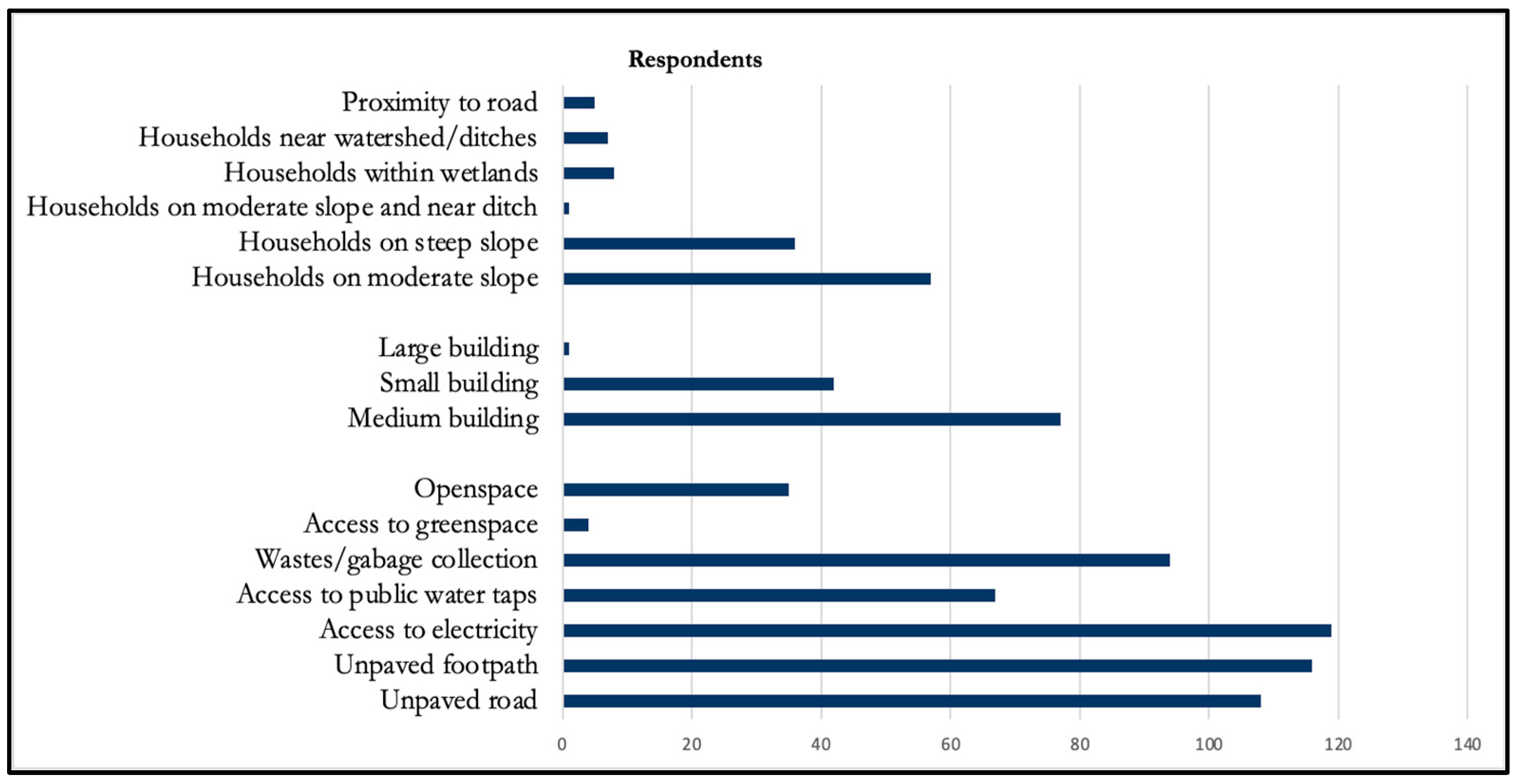

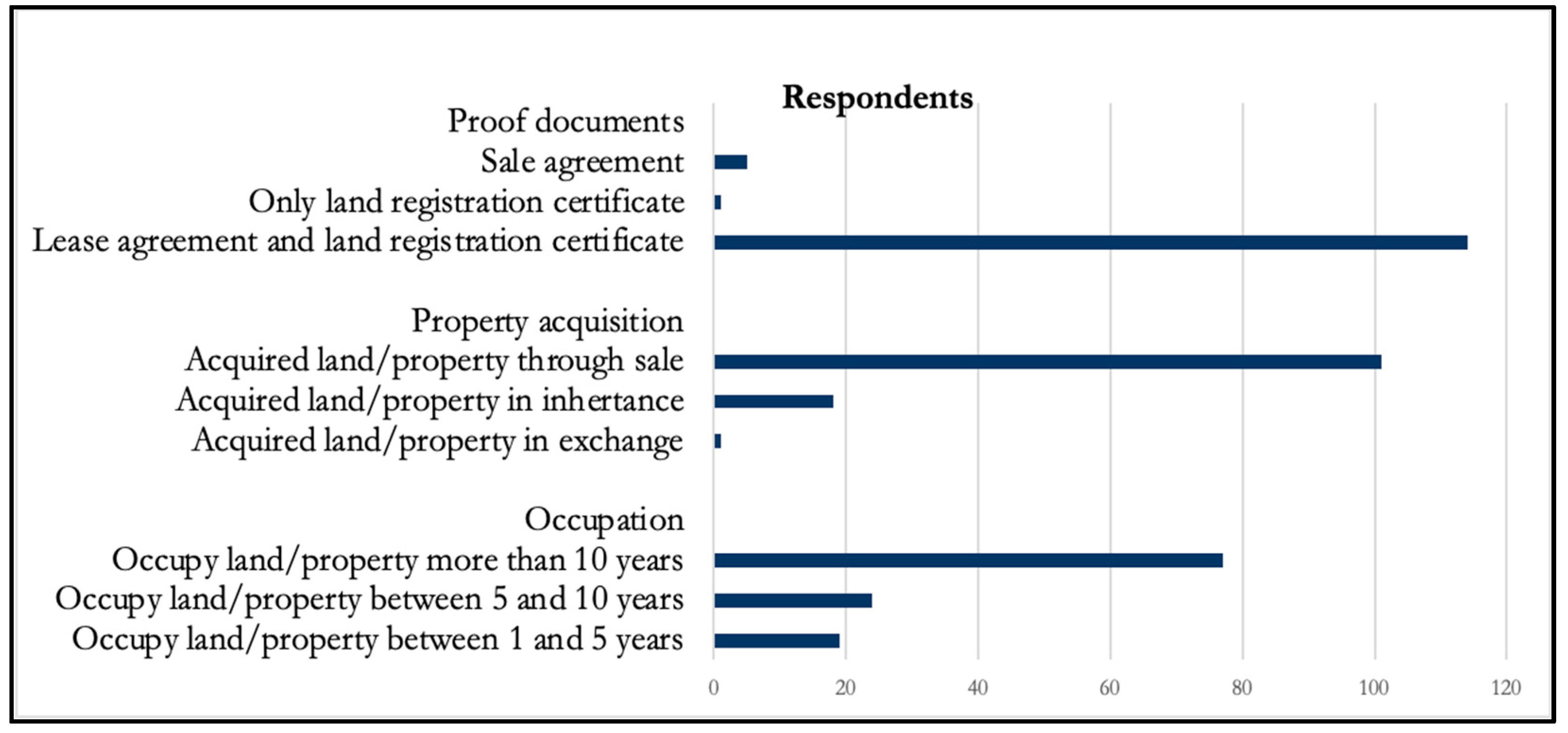
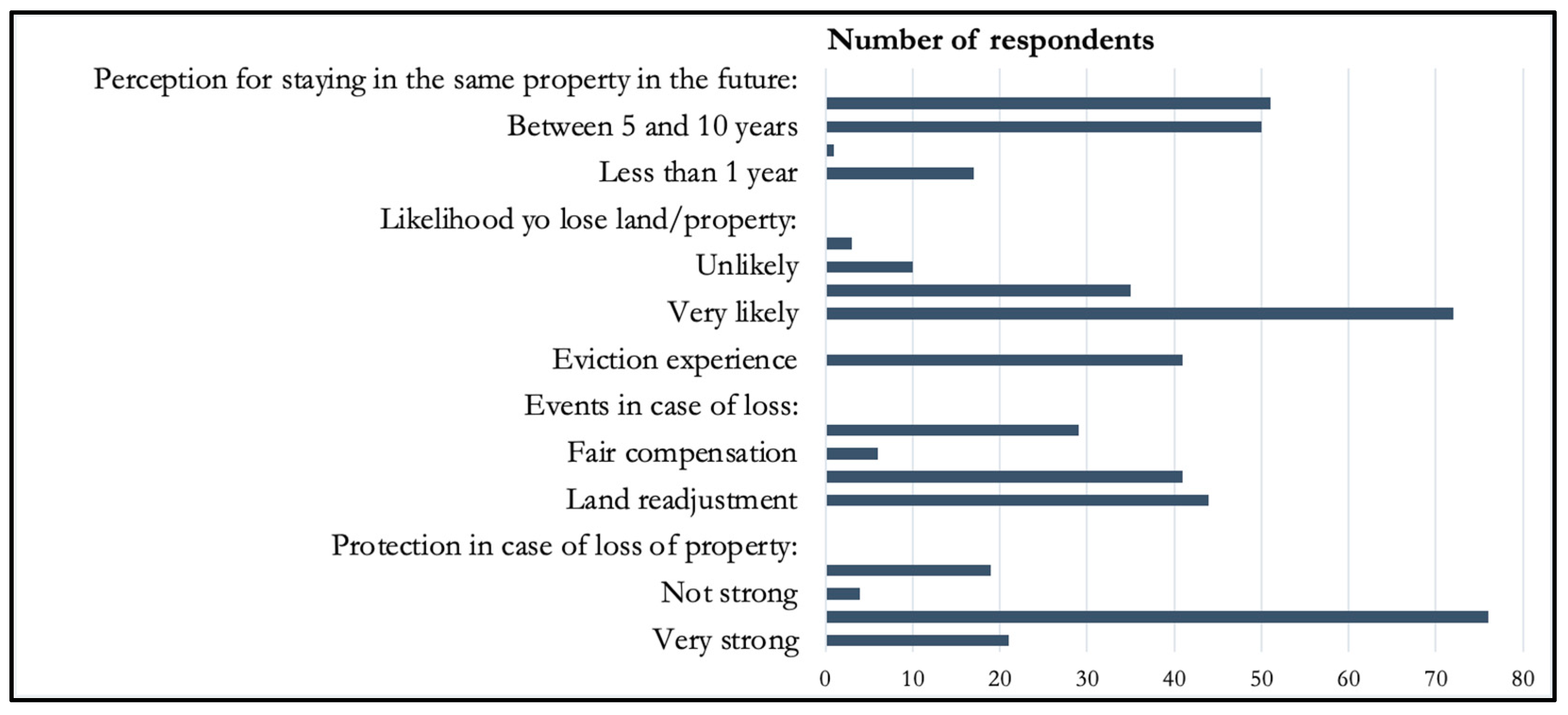

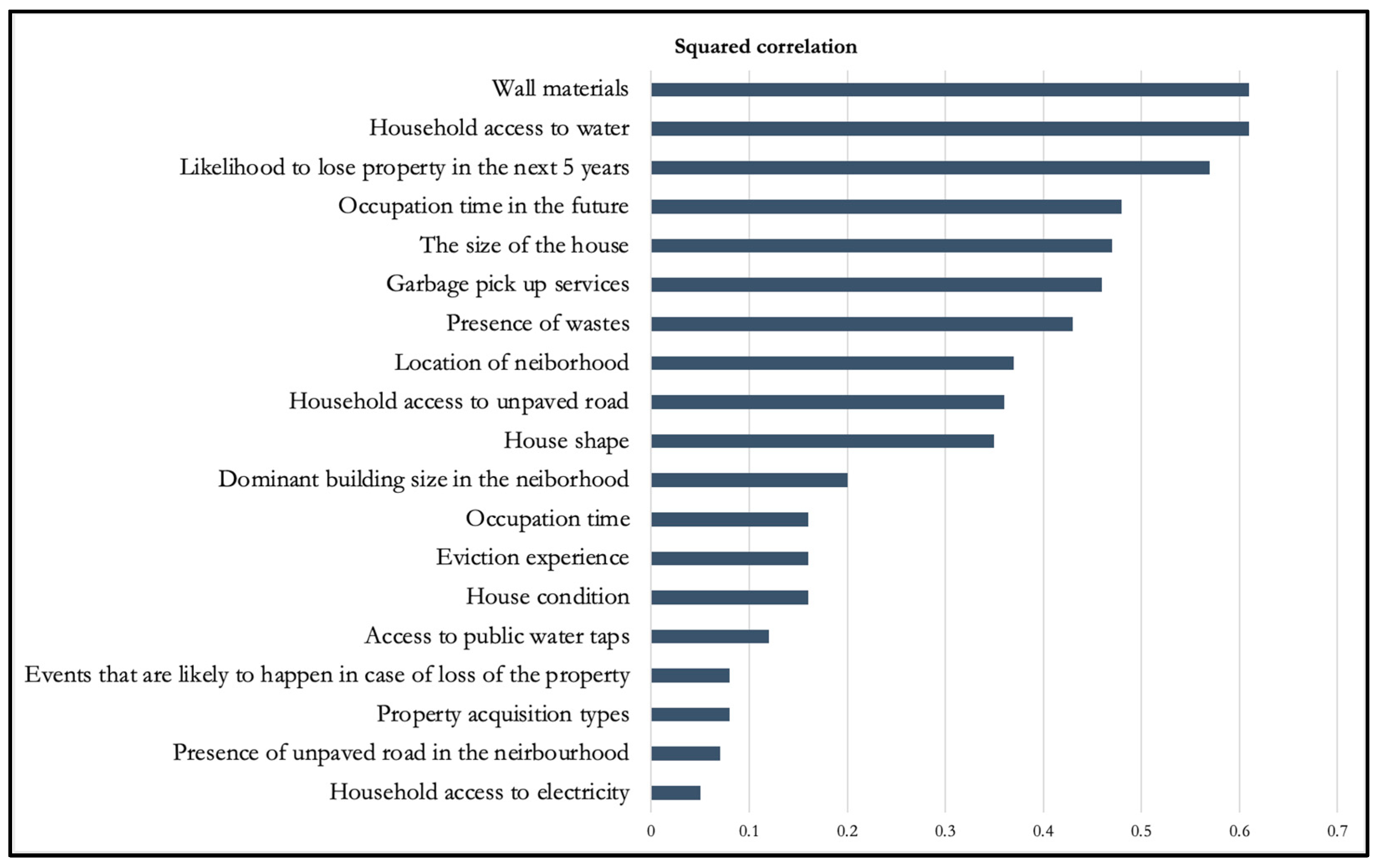
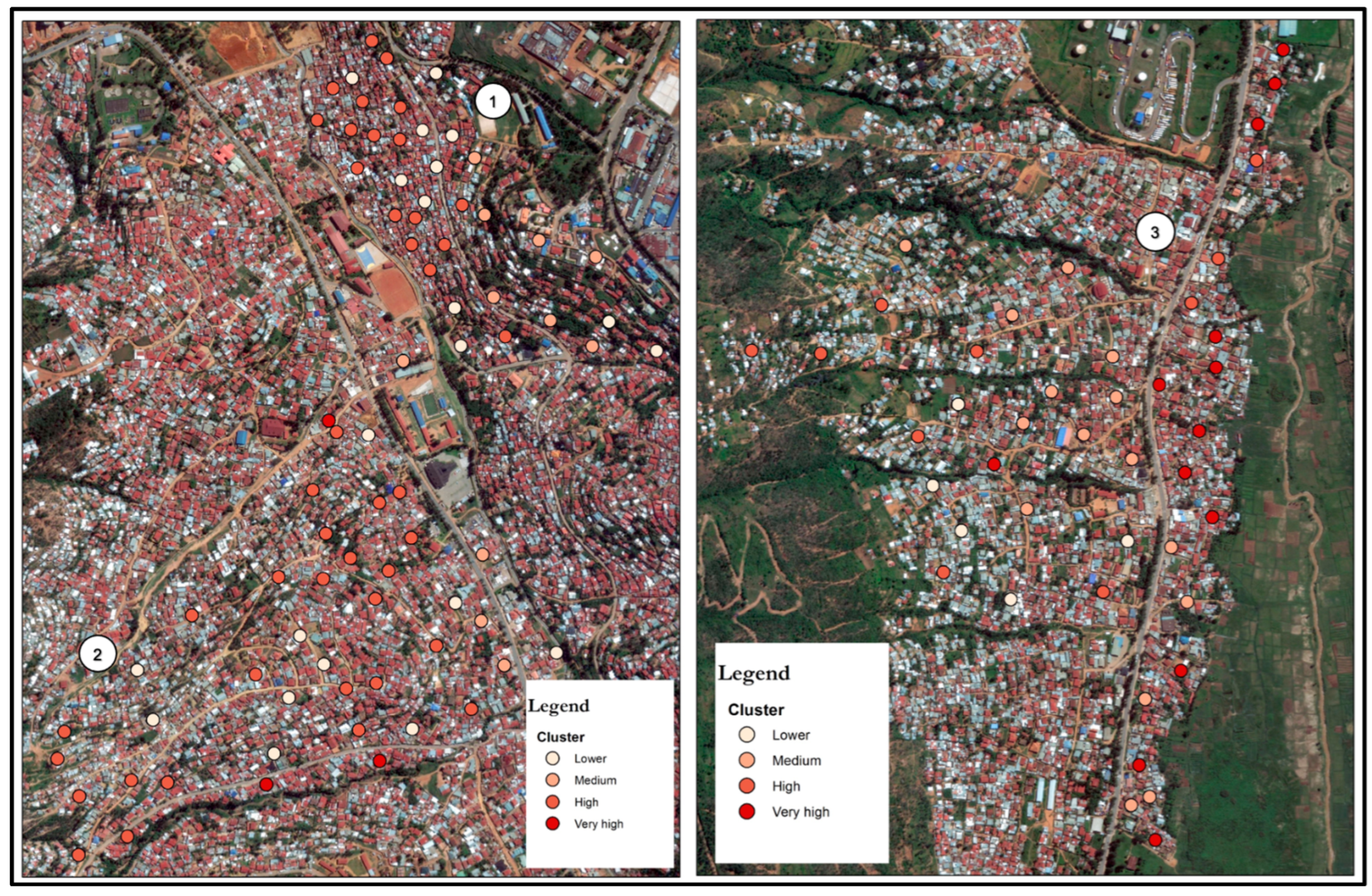
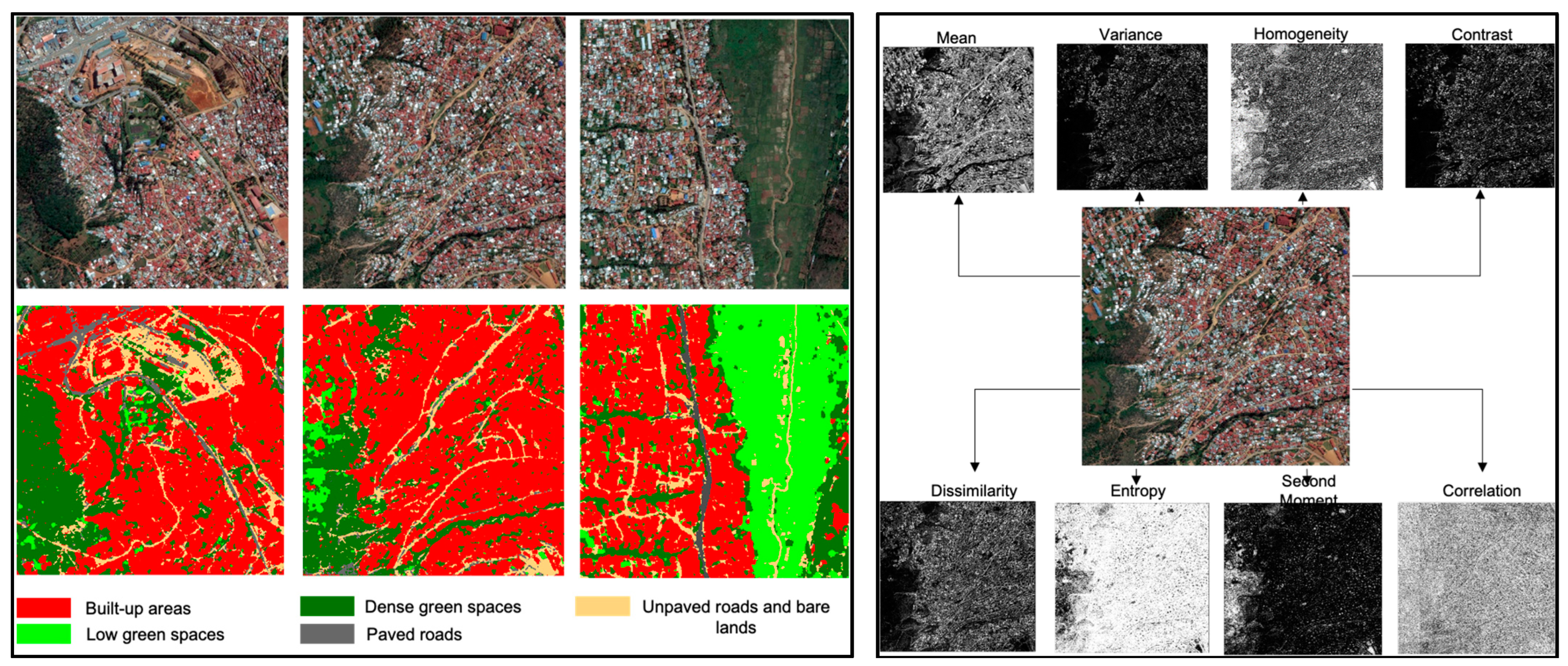
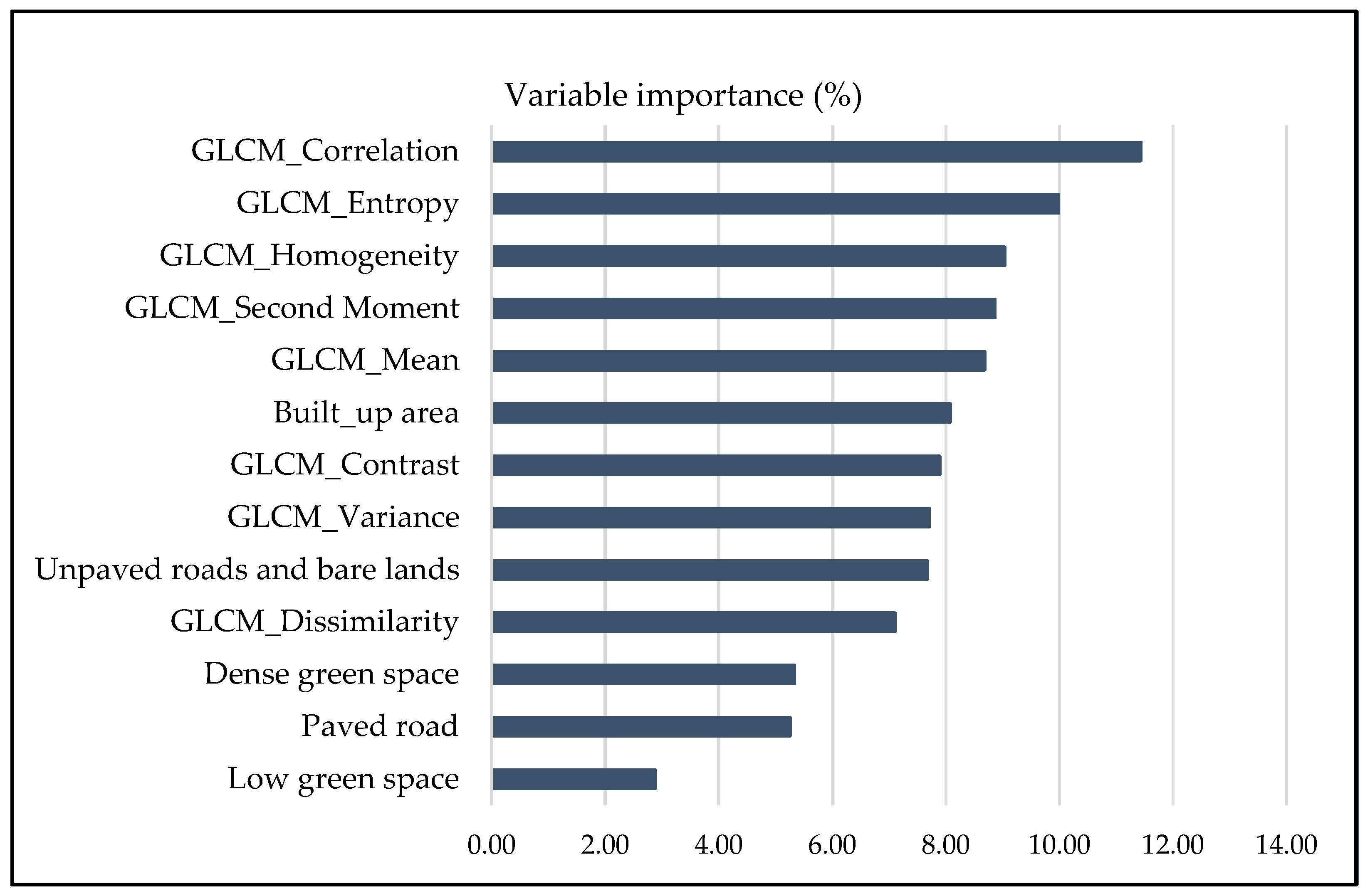

| Category | Variable | Description |
|---|---|---|
| Land cover | Built-up area | Percentage of built-up areas |
| Dense green space | Percentage of dense green spaces | |
| Low green space | Percentage of low green spaces | |
| Paved roads | Percentage of paved areas | |
| Unpaved roads and bare lands | Percentage of unpaved roads and bare lands | |
| Texture features | GLCM_Contrast | Texture features extracted through GLCM contrast |
| GLCM_Correlation | Texture features extracted through GLCM correlation | |
| GLCM_Dissimilarity | Texture features extracted through GLCM dissimilarity | |
| GLCM_Entropy | Texture features extracted through GLCM entropy | |
| GLCM_Homogeneity | Texture features extracted through GLCM homogeneity | |
| GLCM_Mean | Texture features extracted through GLCM mean | |
| GLCM_Second Moment | Texture features extracted through GLCM second moment | |
| GLCM_Variance | Texture features extracted through GLCM variance | |
| Additional spatial information | Distance to road | Accessibility to road |
| Distance to wetland | Proximity to wetland | |
| Slope | Slope (%) derived from DEM representing the topography | |
| Residential_R1 | Planned low residential zone derived from the zoning plan | |
| Residential_R1B | Planned rural residential zone derived from the zoning plan | |
| Transportation facilities | Planned transportation facilities derived from the zoning plan |
| Test Statistic | ||||
|---|---|---|---|---|
| Cluster 1 | Cluster 2 | Cluster 3 | Cluster 4 | |
| First dimension | −3.797 | −6.298 | 4.331 | 6.788 |
| Second dimension | −2.970 | 3.581 | −7.023 | 5.517 |
| Land Cover Class | Recall | Precision | F1-Score |
|---|---|---|---|
| Built-up area | 0.92 | 0.90 | 0.91 |
| Low green space | 0.88 | 0.89 | 0.88 |
| Dense green space | 0.93 | 0.91 | 0.92 |
| Paved roads | 0.85 | 0.84 | 0.84 |
| Unpaved roads and bare lands | 0.85 | 0.86 | 0.85 |
| Physical Indicators (from Survey Data) | Spatial Characteristics (Detected from VHR GE Image) | Comment |
|---|---|---|
| Wall materials | − | Difficult to capture but can be captured using oblique VHR Unmanned Aerial Vehicle image |
| Location of the neighbourhood | − | Not detected (Slope was used instead) |
| House condition | + | Partially detected through GLCM texture and spectral features |
| Shape of the house | + | Partially detected through GLCM texture features |
| Presence of the wastes | − | Not detected |
| Size of the house | + | Partially detected through GLCM texture features |
| Dominant building size in the neighbourhood | + | Partially detected through GLCM texture features |
| Household access to the unpaved road | ++ | Detected as the unpaved road land cover class |
| Access to green space | ++ | Detected as the dense and low green spaces land cover class |
| Presence of unpaved road in the neighbourhood | ++ | Detected as the unpaved road land cover class |
| Presence of unpaved footpath | + | Not fully detected, but a portion of it detected as unpaved roads and bare lands |
| Buffer-Wise Squared Correlation (R2) | ||||
|---|---|---|---|---|
| Buffer (in meters) | 10 | 15 | 20 | 25 |
| Only VHR GE image derived spatial characteristics | 0.22 | 0.27 | 0.45 | 0.44 |
| With additional spatial information layers | 0.40 | 0.36 | 0.60 | 0.61 |
Disclaimer/Publisher’s Note: The statements, opinions and data contained in all publications are solely those of the individual author(s) and contributor(s) and not of MDPI and/or the editor(s). MDPI and/or the editor(s) disclaim responsibility for any injury to people or property resulting from any ideas, methods, instructions or products referred to in the content. |
© 2024 by the authors. Licensee MDPI, Basel, Switzerland. This article is an open access article distributed under the terms and conditions of the Creative Commons Attribution (CC BY) license (https://creativecommons.org/licenses/by/4.0/).
Share and Cite
Dufitimana, E.; Wang, J.; Kohli-Poll Jonker, D. Leveraging Geospatial Information to Map Perceived Tenure Insecurity in Urban Deprivation Areas. Land 2024, 13, 1429. https://doi.org/10.3390/land13091429
Dufitimana E, Wang J, Kohli-Poll Jonker D. Leveraging Geospatial Information to Map Perceived Tenure Insecurity in Urban Deprivation Areas. Land. 2024; 13(9):1429. https://doi.org/10.3390/land13091429
Chicago/Turabian StyleDufitimana, Esaie, Jiong Wang, and Divyani Kohli-Poll Jonker. 2024. "Leveraging Geospatial Information to Map Perceived Tenure Insecurity in Urban Deprivation Areas" Land 13, no. 9: 1429. https://doi.org/10.3390/land13091429
APA StyleDufitimana, E., Wang, J., & Kohli-Poll Jonker, D. (2024). Leveraging Geospatial Information to Map Perceived Tenure Insecurity in Urban Deprivation Areas. Land, 13(9), 1429. https://doi.org/10.3390/land13091429






